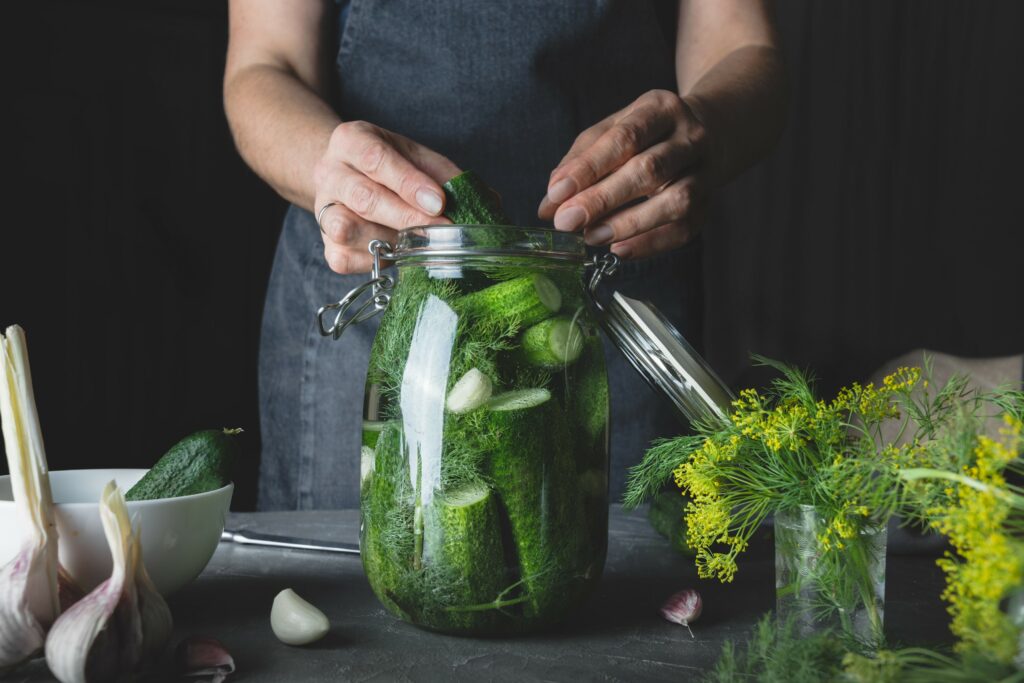Are prebiotics different from probiotics? Do I need both of these?
These are a few of the questions I get when someone brings up the subject. To help you understand, read on and allow the ideas to ferment until you have clarity down to your gut. A bad joke you will understand better at the end of the article.
What are prebiotics?
The definition of a prebiotic was used the first time in 1995 by Glenn Gibson and Marcel Roberfroid. Since that time the definition and criteria evolved to better classify a prebiotic into the following:
- It should be resistant to acidic pH of stomach, cannot be hydrolyzed by mammalian enzymes, and also should not be absorbed in the gastrointestinal tract,
- It can be fermented by intestinal microbiota, and
- The growth and/or activity of the intestinal bacteria can be selectively stimulated by this compound and this process improves host’s health. [i]
Let’s break that down to normal-speak:
- The stomach doesn’t break a prebiotic down and isn’t absorbed in the gastrointestinal tract.
- Prebiotics can work with other substances in the gut to create the goodies that feed the good gut bacteria through a fermentation process
- Only these specific fibers can be used and fermenting them improves your health.
Fructo-oligosaccharides, [FOS] and galacto-oligosaccharides [GOS} are the two important groups of prebiotics with beneficial effects on human health. Don’t let the long names give you butterflies. I mention these because if you have seen the words Bifidobacteria or Lactobacilli on a prebiotics bottle, they come from FOS and GOS in conjunction with other substances to create the prebiotic tablets. However, realize that you can get these by eating enough fibrous foods. [ii]
Basically, prebiotics are special types of fiber that are used to stimulate growth of bacteria already present in the gut. They are “good” bacteria promoters for your gut.
Prebiotics have been seen to decrease:
- Diarrhea
- Infection
- Inflammation
- Ulcerative colitis
- Gastro intestinal disorders such as irritable bowel syndrome
- Crohn’s disease
But as I have stated in other articles, your body is completely connected. So, the compounds made by the fermentation of these fibers travel through the bloodstream and do more than help your gut. They also:
- Help with decrease respiratory allergies
- Are used as an energy source for various organs – heart, liver, kidney and muscles
- Increase production of Leptin, the hormone in your body fat that helps you maintain a healthy weight by providing the sensation of satiety (feeling full) [iii]
- Appear to benefit glucose metabolism by normalizing plasma glucose levels and increasing glucose uptake [iv]
- Calcium
- Magnesium
- Iron
What foods contain prebiotics?
GOS are present in large quantities in beans, lentils, and chickpeas. [v]
FOS occur naturally in onion, chicory, garlic, asparagus, banana, artichoke, wheat, rye, and barley, and leeks among many other foods. [vi]
Prebiotics you eat in food are safe, on the other hand [or if you turn the other cheek] there may be a flatulence issue with supplementation. Also with supplementation, there have been instances of sepsis, [a serious condition resulting from harmful microorganisms in the blood or other tissues which can lead to the malfunctioning of various organs, shock, and death] or endocarditis, [infection in membrane which lines the inside of the chambers of the heart], with people having HIV, cancer, organ transplants, severe malnutrition or severe diarrhea.
Now that we know what they are and how they work, let’s look at their relationship with probiotics.
What are probiotics?
Probiotics are live microorganisms or cultures found in the gut that are intended to have health benefits when consumed or applied to the body. They can be found in fermented foods, dietary supplements, and beauty products. [vii]
What do probiotics do?
They do a lot and we are constantly finding out more about them. This is a list of how they currently have been shown to be of benefit:
- Boost immunity and overall GI health
- Relieve irritable bowel syndrome symptoms
- Balance gut flora by decreasing the environment that harmful bacteria likes to live in
- Help digest food
- Destroy disease-causing cells
- Produce vitamins
How do prebiotics and probiotics work together?
That is the key. These two work synergistically to create a healthy intestinal tract.
Step One – Prebiotics
The fiber in foods – fruits, vegetables, grains, beans and nuts – clean out the intestinal tract and then become food for probiotics.
That’s right. Prebiotics are breakfast, lunch and dinner for probiotics. It is as if the prebiotics take out the trash in a plot of soil and then feed the soil.
Step Two – Probiotics
The probiotics grow in this rich soil crowding out weeds and making the whole environment better for all the body’s processes.
Probiotics encourage the growth of the good bacteria in the gut. They help you be in a better mood and keep everything in your gut moving right along.
What types of bacteria are in probiotic supplements?
Probiotic supplements may contain a variety of microorganisms. Many of the microorganisms in probiotic products are the same as or similar to probiotic microorganisms that naturally live in our bodies. The most common are bacteria that belong to groups called Lactobacillus and Bifidobacterium. Other bacteria may also be used as probiotics, and so may yeasts such as Saccharomyces boulardii. The most-studied species include Lactobacillus, Bifidobacterium, and Saccharomyces.
Are there any downsides to prebiotics and probiotics?
There is a huge bias leaning towards probiotics being all healthful. The research I have been looking at mainly says everything is great when EATING foods that create the synergy. Having said that, when discussing supplements there have been some negative health results that were removed or not made available to practitioners in various research studies.
“Out of 384 randomized clinical trials, nearly a third gave no information on potential harms associated with probiotics, prebiotics, or products that combine the two, according to authors of the review, which appears in Annals of Internal Medicine”, says Andrew D. Bowser in MD Edge.
An example of this was the use of probiotics with severe acute pancreatitis. Now, I want to be clear. This is a specific disease state and not you with a mild case of diarrhea. The article from The Lancet [viii]stated that prebiotics were not shown to be useful and 16% of the patients died with probiotic use. [ix]
Probiotics appeared helpful with diarrhea from bacteria but not with diarrhea from viral infections.
So, what is the take home message for pre and probiotics?
Here’s the recap –
Pre and probiotics have been shown to help:
- Diarrhea from bacteria
- Colds
- A variety of GI problems
- Even mental health
- The Gut Biome is now being referred to as the Second Brain
- More research is showing a strong connection between mood and gut health
Pre and probiotics have not been shown to help:
- Acute pancreatitis
- Diarrhea from viral infections
- People having HIV, cancer, organ transplants, severe malnutrition or severe diarrhea
Do I need a prebiotic supplement?
Not usually. Start with diet including good fiber sources and fermented foods. Do what YOU can control with your own health. It is all most people need.
Supplements are called supplement [meaning an addition to] because they should be in addition to good fibrous and/or fermented foods.
Should I take a probiotic supplement?
Again, not usually. However, they can be helpful AFTER being on an antibiotic regime. Antibiotics wipe out a lot of your gut biome. But eating high fiber foods is always the first step. Then, eating foods with prebiotics or drinking beverages with prebiotics can be helpful. Lastly, take a supplement.
What is the best time to take a probiotic?
Bacterial survival was best when taken within 30 minutes before or simultaneously with a meal or beverage that contained some fat content. [x]
Speak with a medical professional before starting any supplement.
What are food sources for prebiotics?
- Bananas
- Alliums – garlic, onions, leeks
- Apples
- Jerusalem artichokes
- Dandelion greens
- Asparagus
- Whole grains – barley, oats, wheat bran
- Cocoa powder
- Chickpeas, lentil, most beans
- Flax seeds
- Jicama
- Seaweed [xi]
What are fermented food sources for probiotics?
- Sauerkraut
- Kimchi
- Kombucha
- Miso Soup – add at the end of cooking. Never boil miso soup. That kills the goodies.
- Sour dough bread
- Sour pickles
- Especially homemade! Homemade refrigerated pickles and pickled vegetables
- Check out my No Cook pickles recipe to make your own probiotics. Keep the brine in the fridge and within a few weeks you will see a white substance in the bottom of the jar. That’s the goodies.
And these are not the only foods that make your colon a happy place. Think about putting them together in a meal such as –
- Kidney bean burgers with mustard and refrigerated sauerkraut
- Lentil soup with garlic and onions
- Banana ice cream with apple chunks and cinnamon
My husband often says, “Happy wife, happy life.”
When it comes to gut vitality – Eat what’s Yummy for a happy Tummy.
Or for those with a little gray hair, sing it with me –
YUMMY, YUMMY, YUMMY. I’VE GOT LOVE IN MY TUMMY [from real foods, not Metamucil. Thanks Ohio Express]
[i] Gibson G.R., Scott K.P., Rastall R.A., Tuohy K.M., Hotchkiss A., Dubert-Ferrandon A., Gareau M., Murphy E.F., Saulnier D., Loh G., et al. Dietary prebiotics: Current status and new definition. Food Sci. Technol. Bull. Funct. Foods. 2010;7:1–19. doi: 10.1616/1476-2137.15880.
[ii] Davani-Davari D, Negahdaripour M, Karimzadeh I, Seifan M, Mohkam M, Masoumi SJ, Berenjian A, Ghasemi Y. Prebiotics: Definition, Types, Sources, Mechanisms, and Clinical Applications. Foods. 2019 Mar 9;8(3):92. doi: 10.3390/foods8030092. PMID: 30857316; PMCID: PMC6463098.
[iii]https://my.clevelandclinic.org/health/articles/22446-leptin
[iv]den Besten G, van Eunen K, Groen AK, Venema K, Reijngoud DJ, Bakker BM. The role of short-chain fatty acids in the interplay between diet, gut microbiota, and host energy metabolism. J Lipid Res. 2013 Sep;54(9):2325-40. doi: 10.1194/jlr.R036012. Epub 2013 Jul 2. PMID: 23821742; PMCID: PMC3735932.
[v] https://www.acs.org/content/acs/en/education/resources/highschool/chemmatters/past-issues/archive-2014-2015/fodmap-intolerance.html
[vi] Sabater-Molina, M., Larqué, E., Torrella, F., & Zamora, S. (2009). Dietary fructooligosaccharides and potential benefits on health. Journal of physiology and biochemistry, 65(3), 315–328. https://doi.org/10.1007/BF03180584
[vii] NIH: https://www.nccih.nih.gov/health/probiotics-what-you-need-to-know
[viii] https://www.thelancet.com/journals/lancet/article/PIIS0140-6736(08)60207-X/fulltext
[ix] Hooijmans, C. R., de Vries, R. B., Rovers, M. M., Gooszen, H. G., & Ritskes-Hoitinga, M. (2012). The effects of probiotic supplementation on experimental acute pancreatitis: a systematic review and meta-analysis. PloS one, 7(11), e48811. https://doi.org/10.1371/journal.pone.0048811
[x] Tompkins, T. A., Mainville, I., & Arcand, Y. (2011). The impact of meals on a probiotic during transit through a model of the human upper gastrointestinal tract. Beneficial microbes, 2(4), 295–303. https://doi.org/10.3920/BM2011.0022
[xi]https://www.healthline.com/nutrition/19-best-prebiotic-foods#The-bottom-line

